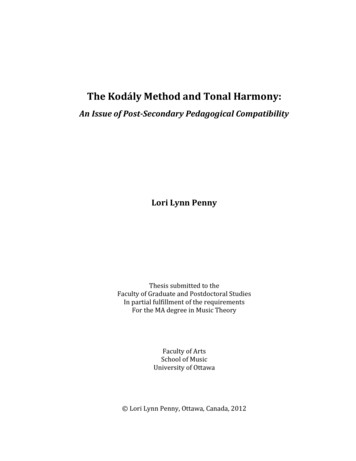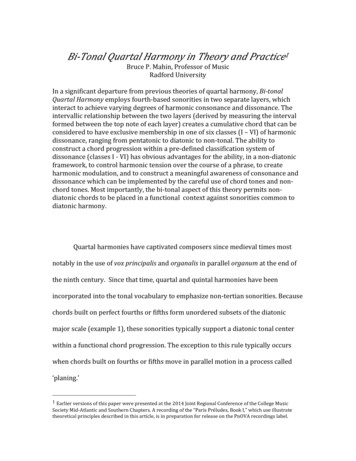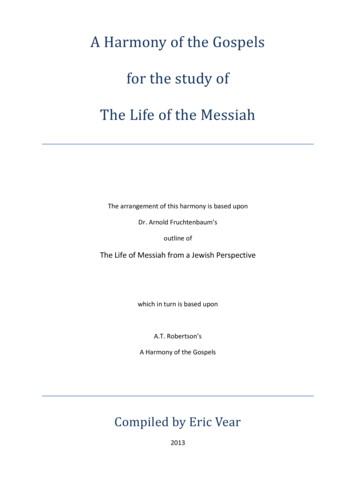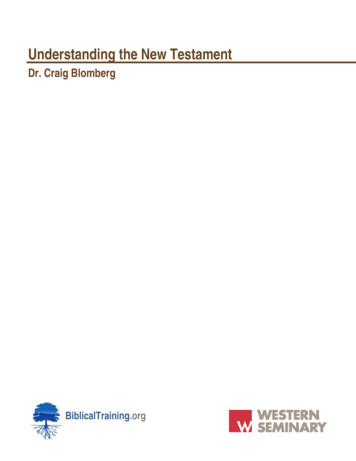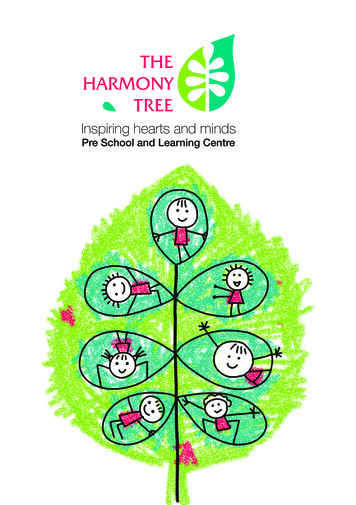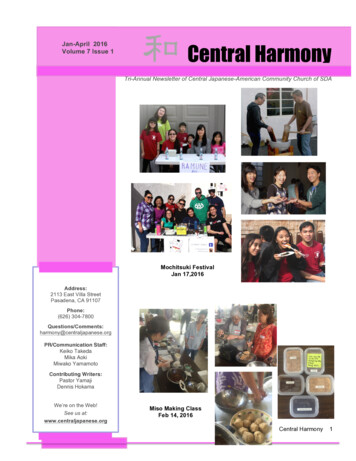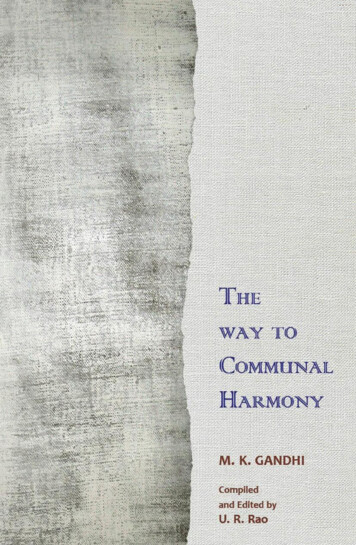
Transcription
THE WAY TO COMMUNALHARMONYM.K. GandhiCompiled and Edited by U.R. RaoForeword by Prof. Humayun KabirIntroduction by Dr. Rajendra PrasadFirst Edition, January 1963Navajivan Publishing House, Ahmedabad 380 014
The Way to Communal Harmony M.K. GandhiFOREWORDMahatma Gandhi wrote his autobiography under the title—The Story of MyExperiments with Truth. This perhaps strikes the keynote to his life. In all that he saidand did, he was continually striving to realize truth for himself and express it to thosearound him. From one point of view, this was essentially a pragmatic approach anddepended on circumstances. That is why one finds many statements in his writingswhich, taken in isolation, are inconsistent with one another. At the same time, hispragmatic approach to problems was inspired by certain basic and unchangingprinciples. He clung to his ideals with intense force and passion. We can therefore finda deep underlying unity in all his statements in spite of their superficialinconsistencies.The Way to Communal Harmony is a compilation of Gandhi’s reflections on certainproblems which divide mankind. Though they deal immediately with India, theirvalidity extends beyond the circumstances of our country. Everywhere in the world,individuals and groups are divided because of fear, suspicion and hatred. It dependson local conditions whether the division expresses itself along religious, economic,political, caste or colour lines. Whatever be the form, insecurity is perhaps the majorcause of individual and social dissensions. A person who is integrated and sure ofhimself fears none and consequently provokes no fear. We have occasional examplesof such heroic individuals, but we have not till now had instances of societies orcommunities that are fully integrated and therefore fearless. The theme of Gandhi’steachings is that the individual must rise above fear, jealousy and hate. When suchindividuals combine themselves into a community, the problem of communal jealousyand discord will disappear.In reading through this selection of Gandhi s writings and speeches, one is struck againand again by the passion and sincerity with which he pleaded the cause of betterunderstanding among individuals and communities. He came to politics from an ethicalurge. Quite early in life, he realized that men will not feel secure till the physicalcauses of conflict—insufficiency of food, shelter and other necessities—have beenremoved. Neither will they feel secure till the mental and moral strength of theindividual has been developed. U. R. Rao has earned our gratitude by collecting in one
The Way to Communal Harmony M.K. Gandhivolume many of the most significant thoughts of Gandhi on the way to achieveindividual and social harmony.Throughout his long life, Gandhi worked for toleration based on understanding andrespect. He pitted all his strength against the forces of evil let loose on the Indiansub-continent during the critical years when independence was achieved. His wholelife was a saga of sacrifice, but perhaps the last six months outshine even themagnificent deeds of his earlier years. He wrote: "I am striving to become the bestcement between the two communities. My longing is to be able to cement the twowith my blood, if necessary." These words proved prophetic and he laid down his lifeto establish understanding and respect not only between the two major communitiesof India but among all communities in this sub-continent and, by implication, amongall communities throughout the world.New Delhi, August 15, 1962
The Way to Communal Harmony M.K. GandhiINTRODUCTIONIt was rather at an early stage of his public life in South Africa that Mahatma Gandhifelt the necessity of communal unity. There were people from different parts of Indialiving there and in fact, it was to some extent, an India in miniature, with itsdifferences of language, religion, custom, etc. In the course of his struggle in SouthAfrica, he had to secure the willing co-operation and sacrifice of all Indians residingthere. He returned to India with a conviction that, if the struggle for Swaraj had tosucceed, it could do so only with the co-operation of all the communities living withinthis vast sub-continent. Thus, he became keen to establish communal harmony.The principal communal question was one of harmony between Hindus and Musalmanswho inhabited this country. Mahatma Gandhi felt that, if Hindu-Muslim unity wasestablished, unity with other communities—which was already there—could easily bestrengthened. He never found any serious differences between the Hindus and otherminority communities like the Christians and the Sikhs, not to speak of the smallcommunity of the Parsis. Naturally, therefore, he turned to the question of Hindu Muslim unity. Events so happened that they made special joint efforts, particularly ofthe Hindus and the Muslims, necessary. After the First World War, there was greatagitation among the Muslims against the British Government on account of what theyconsidered to be a breach of faith. It was also on account of the attitude which theBritish Government had taken at the time of the Peace Treaty in disregarding thepromises hitherto made concerning the position of the Sultan of Turkey, who wasregarded as Khalifa by the Muslims in India and thus, charged with the duty of andclothed with authority for protecting the holy places of Islam. About the same time,the British Government roused to indignation other Indian communities by its attemptto perpetuate the emergency laws which had been passed and enforced with rigourduring the War period. This led Mahatma Gandhi to voice the nation's feeling ofbitterness and, particularly, forced him to think of Satyagraha against theGovernment. The tragic massacre of Hindus, Muslims and Sikhs collectively atJalianwalla Bagh and the subsequent atrocities and humiliations, heaped uponmembers of all communities in the Punjab during he Martial Law days, had created anintense resentment amongst all classes. Thus, when the general resentment of allcommunities over the Punjab atrocities combined with the resentment of the Muslims
The Way to Communal Harmony M.K. Gandhion account of the Khilafat wrongs, an agitation of a most intense type was the result.The Hindus as a community took up the question of the Khilafat with the same zealand vigour as the Muslims, and Mahatma Gandhi seemed to have become the leaderof both Hindus and Muslims. He toured throughout the country with the Ali brothersand Muslim leaders like Maulana Abul Kalam Azad and many others, and carried themessage of resistance to the Government for what came to be known as the Khilafatand the Punjab wrongs. For about a year it seemed almost as if a permanent unity hadbeen achieved. One cause for differences between the Hindus and the Muslims usedto be the sacrifice of cows by Muslims on the day of Bakr-Id. In that particular year,the number of cows sacrificed on the day of Bakr-Id was almost negligible as comparedwith that in the previous years. Mahatma Gandhi was never tired of preaching thatthe Hindus should leave it to the Muslims to protect the cow, as they (the Hindus) hadbeen doing their best to help the Khilafat. Fraternization became common all overthe country. Those amongst the Hindus who did not have faith in Mahatma Gandhi’spolicy of unity and the Muslims who did not trust the Hindus seemed to have lost theirinfluence for the time being and were more or less out of action. Mahatma Gandhi ’sidea of unity, like all of his other ideas, was based on the principle of Ahimsa whichteaches us not to give even mental pain to anyone, not to speak of physical injury. Heinsisted that the Hindus who were in a majority in the country should help the Muslimsand should never entertain any idea of enforcing their rights by brute majority, buttry to win the hearts of the minority community. The Non-co-operation movement,which had been originally conceived only for the redress of the Khilafat and the Punjabwrongs, was at the Calcutta special session of the Congress enlarged in scope toinclude also the attainment of Swaraj. Mahatma Gandhi’s idea was that, if the countrysucceeded in obtaining redress of the Khilafat and the Punjab wrongs through force ofpublic opinion, supported by people’s sacrifices, that itself would be tantamount toobtaining Swaraj—which could not thereafter be held up by the British. But to makethe position clear and to make the appeal of the Congress most forcible so far as allcommunities in India were concerned, he added to its objectives the achievement ofSwaraj.As I have said above, everything went on well for about a year. But, probably therewere forces working behind the scenes. Hindu-Muslim riots were started on a largescale in Kerala and, in subsequent years, in many places all over the country. The
The Way to Communal Harmony M.K. GandhiKhilafat movement also lost its motive force when the Khalifa himself was deposed bythe Turks. In spite of these setbacks in the early days, however, Mahatma Gandhiremained firm in his faith in Hindu-Muslim unity. In his view it was synonymous withcommunal unity or unity amongst all the communities of India, and he continued tofight bravely for this unity till the end of his life.When the Hindu-Muslim riots broke out in 1924 and the situation became intolerableto him, he undertook a fast for 21 days—not aimed against any individual or anycommunity—but with a view, as he said, to purifying himself so that his words and hisactions could be better understood and appreciated. One immediate result of his fastwas that an All-Party Conference was held in which Hindus, Muslims, Christians andother communities participated and adopted a resolution for achieving andmaintaining communal unity and laid down the procedure which was to be followedin removing the causes of friction and distrust.After the first flush of its enthusiasm for Non-co-operation had waned, the Congressdivided its activities into two: work in the legislatures and the constructiveprogramme. The first activity was entrusted to the Swaraj Party of which the mostdistinguished leaders were Deshbandhu C. R. Das, Pandit Motilal Nehru, Shri VithalbhaiPatel, Shri N.C. Kelkar, Shri Govind Vallabh Pant and others. The Congress itself tookup constructive work for the spread of spinning and Khadi, reorganization of nationaleducation and general village uplift work. Mahatma Gandhi was at the head of thismovement and, amongst his colleagues and associates the most prominent were ShriC. Rajagopalachari, Shri Vallabhbhai Patel, Shri Jamnalal Bajaj and others. Thingswent on for some years, each group giving as good an account of itself as possible inthose difficult tasks. Ultimately, a time came when not only Hindus and Muslims butall communities became once more united against the British Government. On thisoccasion also, an act of the British Government brought about unity. The Governmentappointed a commission, known as the Simon Commission, under the chairmanship ofSir John Simon, for making proposals for giving a larger share to the people of India inthe governance of their country. There was no Indian on this Commission and thiscreated resentment not only among Congressmen—both Hindu and Muslim- but alsoamong those who had till then kept themselves out and opposed the Congressmovement of Non-co-operation. However, Mahatma Gandhi continued to work for hisconstructive programme and communal unity. The Non-co-operation movement had
The Way to Communal Harmony M.K. Gandhiexhibited its strength but had to be stopped or withdrawn by Mahatma Gandhi onaccount of the unpreparedness of the country for the final struggle and chieflybecause, in his view, the kind of unity which he had hoped for and the degree of nonviolence which he had tried to inculcate amongst the people at large had not beenachieved. Muslims, however, gradually drifted away from the Congress and theCongress movement, and with the exception of a small group of stalwarts amongstwhom the most prominent was Maulana Abul Kalam Azad, practically the wholecommunity became indifferent, if not hostile, to what the Congress was doing. AMuslim League had been in existence and it offered a platform for those Muslims whodid not find themselves in agreement with the Congress. Before the Muslim Leagueemerged as a power demanding division of India into Muslim and non-Muslim India,there were some who had been working in their own silent way and carrying onpropaganda among Muslim intellectuals. But Mahatma Gandhi did not lose faith andcontinued to work for unity, especially Hindu-Muslim unity. The time came, however,when India became more or less divided into two; the Muslims on one side and all therest on the other side. There may have been forces, working under the instigation ofthe British Government, trying to widen the gulf and setting one community againstthe other in all possible ways. The Non-co-operation movement was succeeded by CivilDisobedience or Satyagraha; thousands and thousands of people, including quite agood number of Muslims, disobeyed laws and sought imprisonment. The rise of theMuslim League held out before the Muslims the picture of a divided India and aseparate Muslim State on the basis of the theory that the Muslims and the Hindusconstituted two different nations and that the Muslims were consequently entitled toan independent home for themselves within the territory of India but separate fromthe rest of the country. This demand of the League attracted more and more Muslimsto its side. The Congress never accepted the theory that the Hindus and the Muslimswere two different nations. They had been born in the same country; their ancestorsfor many generations had lived and died in this country; they were sharing jointly allthe sorrows of a common life, especially the burden of a foreign rule which had beenestablished on the ashes of the Muslim empire. The Muslim League, on the other hand,propagated its two nation theory and, later, laid claim to a separate homeland for theMuslims. Mahatma Gandhi was prepared to go a very long way to satisfy the Muslimdemand, short of partition of the country. But he who had worked shoulder to shoulder
The Way to Communal Harmony M.K. Gandhiwith prominent Muslims during the Khilafat movement came to be regarded as enemyNo. 1 by many of them. Even some of those who had been among his closest associatesalso joined the Muslim League and supported all that it stood for. All that had beendone for Hindu-Muslim unity was in a way wiped out by the acceptance andpropagation of the two-nation theory.But the most tragic time came when, in anticipation of the advent of Swaraj and theestablishment of Pakistan, large-scale killings were started and thousands andthousands of Hindus and Muslims lost their lives. There was a large, forced exodus ofHindus and Sikhs from the Punjab, Sindh, the North-West Frontier Province and asimilar exodus of Muslims from Eastern Punjab and the adjoining areas. In Bengal,also, there was a large exodus of Hindus from Eastern Bengal, an exodus that has notcompletely ceased even today. A joint cabinet in the Government of India withrepresentatives of both the Congress and the League was formed, but the experienceof joint working even for a short time forced the belief on those Congressmen whowere in the Government that there was no other way but to accept partition. And sopartition came.It was hoped by the Congress members of the Government that with the withdrawalof the objection to partition by the Congress, there would be peace in both parts ofthe country; and the Hindus and the Sikhs in Pakistan and the Muslims in Hindustanwould be able to live in peace and harmony in their respective places carrying on theirnormal business; but that was not to be. There were massacres in many places. WestPakistan for all practical purposes became a country exclusively for Muslims exceptfor a small group of the minority communities, and, similarly, East Punjab and someother adjoining areas became a non-Muslim region except for pockets which were, andstill are, of a sizable character. In East Bengal, however, the Hindu population waslarge and in spite of the forced exodus of nearly 50 lakhs of people, there is still alarge population of Hindus left.The most prominent feature of Mahatma Gandhi’s life was that, when wholesalemassacres and arson and loot were being carried on on a large scale; he tried hisutmost to stop the holocaust and to bring about some sort of reconciliation. In hiswritings and speeches of this period particularly, the essential and more significantpart of which is presented in the following pages, is evidence of his burning desire to
The Way to Communal Harmony M.K. Gandhiestablish communal unity and to shed ill-will. He rushed to Noakhali where the Muslimswere in a majority, forming nearly 90% of the population, and where innumerableatrocities had been committed against the Hindu minority. There not only did he liveamongst the Muslims but also walked from village to village on his mission of peaceand asked his companions and followers to do the same in different parts of thedistrict. When riots broke out in Bihar, in which Hindus had the upper hand andcommitted horrible crimes against the Muslims, his heart wept. But on that occasionat least the love of the people of Bihar for him asserted itself and at the news of thethreat that he would undertake a fast, the riots subsided in no time. Thereafter hecame to Bihar and tried to heal the wounds of the Muslim sufferers. He would havegone to the Punjab on a similar mission of mercy but was held up in Delhi where, too,communal fury was brought under control by his fast. Similarly, in Calcutta, whereboth Hindus and Muslims had suffered terribly at each other’s hands, he exposedhimself to the utmost risk and achieved what was described at the time as a marvel,by re-establishing peace between the communities.Mahatma Gandhi had never accepted in principle the theory of the Hindus and theMuslims being two distinct nations, and he tried hard to convince both of them of itspernicious character. He continued to the last day of his life to instil the lesson ofunity among the communities of India. It is remarkable how by his honest and fearlessadvocacy of communal unity he had enraged many of the Muslims and a negligible fewamong the Hindus; the Muslims as a body, with a few exceptions, looked upon him asan enemy, while some Hindus felt that, by showing humility, respect and regard and"partiality" for Muslims, he was jeopardizing the cause of the Hindus. This had been,in a way, going on from the days of the Khilafat movement but reached its acme afterthe partition. Those Hindus who did not like his indefatigable efforts to give protectionto the Muslims from murder, arson and loot conceived the idea of getting rid of him,and so, one evening while he was on his way to his prayers, he was shot on the prayerground. He died, with He Ram on his lips and a smile on his face.This is the long and tragic history of Mahatma Gandhi’s attempts to establish HinduMuslim unity which ended with the establishment of Pakistan on the one side and hissupreme sacrifice on the other. The problem has, however, not been solved in spiteof the creation of Pakistan. We have still some 40 millions of Muslims in this country,spread all over the vast area of what is called India today. There are, moreover, other
The Way to Communal Harmony M.K. Gandhiproblems which are cropping up now. They are not of the type and intensity of theHindu-Muslim problem of the earlier days, but they are important enough to be viewedwith concern by all lovers of the country. The advent of Swaraj has brought its ownproblems and not the least amongst them is the psychological and moral integrationof all the elements living in this country into one, unified whole, for which everyoneliving in this territory has not only to develop love and affection, but for whoseprotection and prosperity, he has also to be prepared to make sacrifices. In thisconnection, it is worthwhile to recall some of the salient features of Mahatma Gandhi’steachings. The fundamental thesis which he developed and propagated was based onhis faith in Ahimsa and Truth. He believed and preached that unity was a vital needof this country—and we may add, today it is an equally vital need of the world—andthat it should be based on love, not fear, on trust and good faith, not hatred anddistrust. It should be the aim and object of all to achieve at least peace and goodwillif not unity, not by force, nor by aggression, but by love and sacrifice. It was the duty,in his view, of the stronger party to behave not only justly but even generously towardsthe weaker party. It had not to show condescension towards the other but to win theother’s love and affection. He wanted to replace exploitation of the weak by thestrong by a spirit of mutual respect and surrender by the stronger to the weaker.Science and technology have brought the different countries of the world to a positionin which they can and must live in co-operation with one another or perish. In thisatomic age—an age of atomic weapons of mass destruction—there is no other way. The'Big Powers' must come to terms and cat off fear and distrust of one another and thusprepare the way for the establishment of that One World wherein all will be politicallyfree, all will be economically well provided for and each will be contributing to theprosperity and happiness of all.Camp: HyderabadAugust 15, 1962
The Way to Communal Harmony M.K. GandhiEDITOR'S NOTEIn undertaking this work, I have been impelled by a growing conviction that, as thedays pass and Gandhiji recedes more and more from us into history, the Truth whichhe put before us assumes a more crucial and compelling validity to contemporaryproblems. We stand today in the heart of the Nuclear Age and are already reachingout into the Space Age. Never before in the known annals of the human race has mangained such mastery over the forces of the physical universe. Yet, if we look at theparochialism and the pettiness, the jealousy and the intolerance, the hatred and theviolence that divide man from man and nation from nation, it is evident that our moraland spiritual growth has not kept pace with our intellectual and material progress.This may sound platitudinous, but is nevertheless true.The social, political, racial and international tensions and conflicts which threaten thevery existence of mankind today have all their seeds in the soil of our minds. The soiltherefore needs to be dug up down to the very roots and turned over to the seeds ofmutual understanding and respect, love and co-operation. Else, humanity will perish.Gandhiji showed us the way not only to retrace our steps but also to reach unity oflife. This he did not do through mere abstractions and aphorisms, precepts andsermons. The road to communal harmony is marked with the imprints of his life -longpilgrimage for peace among men, and sanctified by his supreme sacrifice. So was it inthe case of Jesus Christ. We shall ignore the one—as we have ignored the other—atour peril.Freedom for us in India has been won through the sufferings and struggle of countlessmen and women, turned into heroes by the alchemy of Gandhiji’s touch. Today wehave to ask ourselves: Will the people be finally welded into one nation? Will unity ofhearts and community of purpose be achieved? And will they merge into a joining ofhands for raising the edifice of the India of Gandhiji’s dreams? The unity pledge thathe and the people took over 40 years ago has great relevance today. We are in searchof a code of conduct for national integration. Shall we see, strewn among significantutterances and writings of Gandhiji and the doings of his life, strands which can bewoven into a bond of abiding unity of hearts?In the following pages, I have endeavoured to present the truths which Gandhijienunciated—in his own words. There is no substitute for them because they are words
The Way to Communal Harmony M.K. Gandhiborn out of the depths of his own rich and intimate experience, and possess, on thataccount, a spiritual vigour and impact which no mere intellectual effort can everattain.It is no accident that more than half the material in this compilation relates to theyears 1946-48, the crowning period of Gandhiji’s life. Then, more than ever, he hadtranscended politics and risen to the heights of humanity's loftiest religion. During thistime of unprecedented fraternal strife, when men’s minds everywhere were torturedand torn up by anguish, bitterness, disillusionment and suspicion, Gandhiji had manyheart-searching, and indeed, searing, questions to face, both in his correspondenceand at his prayer meetings. Yet when he wrote or spoke in response to them, ‘he didso, sometimes with his self confidence shaken, but always with unwavering faith inthe validity of the truths he had preached and practised throughout his life. True,they were ancient, eternal truths, as 'old as the hills', but he resurrected andrevitalized them and made them throb with the pulse of his own life, working theminto his own living words and deeds. The miracles he had wrought in Calcutta, Biharand Delhi bore unmistakable testimony to the innate vitality of those truths. It wasnot that he failed us; rather, we failed him.Gandhiji’s thoughts and reflections put together in this compilation have been culledfrom almost a couple of thousand pages of his writings, speeches and letters, spreadover three decades of his active public life. The task of selection has been no easyone. Despite my anxiety and effort to omit nothing that is relevant and valuable, it ismore than likely that something significant has been overlooked. Limitations of spacewere there: the book had to be kept within reasonable dimensions. Liberty had to betaken to render the reported, indirect versions of Gandhiji's prayer-time utterances—except in the case of the written texts of his ‘silence-day' messages and statements—into direct speech. Every endeavour has been made to keep as close to the original aspossible. The paragraph headings are very largely mine. Again, shorn of detail andcontext, there is a risk that stray passages may acquire a shade or turn of meaning notwholly warranted by the original from which they are extracted. Gandhiji’s apparentinconsistency—he considered foolish consistency the hobgoblin of little minds—maysometimes seem accentuated because of separation from surrounding material. Thusthere are defects and shortcomings of the method, added to those of my own. For allthese I plead the indulgence of the reader and take consolation in the hope that, when
The Way to Communal Harmony M.K. Gandhiin doubt, he will go to the original sources from which I have drawn and which I havelisted at the end. The notes, mostly the bare minimum, I trust, will help. The glossaryis intended for readers unfamiliar with classical Indian terms, allusions, charactersetc.I must record here my deep indebtedness - to Dr. Rajendra Prasad for the introduction,which provides, among other things, an almost complete and touching historicalperspective to Gandhiji's thoughts on the communal problem; to Prof. Humayun Kabirfor the foreword, which constitutes a brief but eloquent assessment of Gandhiji'scontribution to humanity's heritage; to Shri Kaka Kalelkar, Shri Jairamdas Daulatramand Shri R. R. Diwakar for their interest in this undertaking and advice andencouragement to me in carrying it out; and finally, to Shri Jivanji D. Desai ofNavajivan Trust for his patience and understanding in regard to the production of thebook, which has not been altogether easy and without impediments.If this effort of mine contributes in however small a measure to the understanding andpromotion of "that unity without which life itself will not be worth living", I shallconsider myself amply rewarded.October 2, 1962U.R. Rao
The Way to Communal Harmony M.K. GandhiCONTENTForewordIntroductionEditor's NoteI. Approach to Communal Unity1. Early Background2. Character of Communal Unity3. Hindu-Muslim Unity4. Equal Servant of All5. CommunalismII. Achievement of Communal Unity1.Common Interests2.Arbitration: Key to Solution3.Mutual Tolerance4.The Unitary Method5.Pacts6.Interdining and Intermarriage7.Oneness of Costume8.The Vow of Unity9.The Meaning of Unity10. Work for UnityIII. Religious Aspects of the Communal Problem1.Religion and Communal Unity2.Hinduism and the Communal Problem3.Islam and The Communal Problem4.Conversion5.The Scriptures6.Temples and Mosques7.'Music Before Mosques'8.Congregational Prayer9.Cow-slaughter and Cow-protection
The Way to Communal Harmony M.K. Gandhi10. Untouchability and Caste11. Communal SlogansIV. Problem of Minorities1. Muslims a Minority?2. The Congress and The Minority Problem3. The Congress and The Muslims4. The Sikhs5. Communal Settlement and Swaraj6. Separate ElectoratesV. Communal Disturbances1. Tragedy of Riots2. Riots and Independence3. Partition RiotsVI. The Causes of Communal Riots1. Specific Causes2. Psychology of Fear3. Distrust4. Tiredness of Non-violence5. Propaganda of Vilification6. The Third PartyVII. Social Implications of Communal Riots1. The Goondas and Riots2. Communal Crime and Truth3. Crimes Against Women4. Restoration of PeaceVIII. Personal Reaction To Communal Riots1. Religion and Riots2. Fasts for Communal Peace3. Desire to Live for 125 Years4. Readiness For Martyrdom
The Way to Communal Harmony M.K. GandhiIX. Non-violent Approach to Communal Unity and Peace1. Unity Through Non-violence2. Self-defence: The Violent Way3. Self-defence: The Non-violent Way4. Use of The Military and The Police5. The Way of Non-retaliation6. Non-violence of The Brave7. Martyrdom During Riots8. Peace Brigades9. Duty of a SatyagrahiX. Partition and Pakistan1. The Religi
The principal communal question was one of harmony between Hindus and Musalmans who inhabited this country. Mahatma Gandhi felt that, if Hindu-Muslim unity was . try to win the hearts of the minority community. The Non-co-operation movement, which had been originally conc




